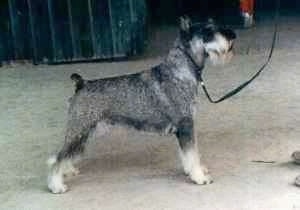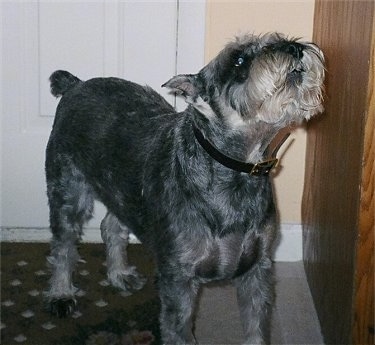Spike the black Standard Schnauzer at 2½years old on his lookout post
STAN-derd SHNOU-zur 
The Standard Schnauzer is a medium-sized, squarely built dog. It looks like a smaller version of the Giant Schnauzer. The skull is moderately broad with a slight stop. The head is long and rectangular. The large nose and the lips are black. The teeth meet in a scissors bite. The oval-shaped, medium-sized eyes are dark brown. The ears are set high on the head and are either cropped or kept natural. When cropped they stand erect with a pointed tip. When left natural, the ears are V-shaped, carried close to the head. The back is straight, with the topline sloping slightly downward from the withers to the rump. The front legs are straight when viewed from all sides. The tail is set high and is usually docked 1-2 inches (2.5-10 cm.). Note: docking tails and cropping ears is illegal in most parts of Europe. The dewclaws may be removed. The small feet are compact with black nails. The double coat has a wiry, dense, hard, outer coat with a soft undercoat. The hair stands slightly up off the back, with coarser, longer, bushy whiskers, beard and eyebrows. Coat colors come in solid black and salt and pepper.
The Standard Schnauzer makes a great watch and guard dog. It is lively, but not restless if provided with enough exercise. Enthusiastic, spunky and affectionate, it tends to have the temperament of a terrier. Bright, intelligent, and playful, Standard Schnauzers need companionship and are good dogs to travel with. This breed has a high learning rate. If the owner does not display a confident demeanor with firm and consistent rules the dog must follow and limits as to what the dog can and cannot do, he can be quite willful, demanding, and may begin to act fearless. He may become untrustworthy with children. May become very protective and dominant, guarding objects, places and people from other people. Along with being this breed’s pack leader, socialize and train him well, and be sure to take him for a daily pack walk to release mental and physical energy. These energetic dogs need active, dominant owners, who have the ability to clearly demonstrate that they are the boss and not the dog and are willing to take the time to keep it well exercised.
Height: Males 18 - 20 inches (46 - 51 cm) Females 17 - 19 inches (43 - 48 cm)
Weight: Males 30 - 45 pounds (14 - 20 kg) Females 30 - 40 pounds (14 - 18 kg)
Ideally, the height should be the same as the length, resulting in a rather square impression.
Some are prone to hip dysplasia and tumors.
The Standard Schnauzer is a good dog for apartment life. It is very active indoors and will do okay without a yard.
These energetic dogs will take as much exercise as they can get. A daily, long, brisk walk or jog is a must. They will also enjoy play sessions during which they can run free. Do not overdo it with very young pups, though, until their body frames are strong and mature. Pups still need to walk, just a shorter distance.
About 15 or more years
About 4-8 puppies
The wiry coat is reasonably easy to look after, but the undercoat is dense and it will become matted unless it is combed or brushed daily with a short wire brush. Clip out knots and brush first with the grain, then against the grain to lift the coat. The animal should be clipped all over to an even length twice a year—in spring and fall. A lot of owners choose to learn how to groom their own dogs rather than take them to a professional. Trim around the eyes and ears with blunt-nosed scissors and clean the whiskers after meals. They have no doggie odor and shed little to no hair, although some owners have reported that their Standards do shed. If you are concerned about shedding ask the breeder if the parents of the dog you are going to adopt sheds.
The Standard Schnauzer originated from Germany and is the oldest of the three Schnauzer breeds. During the years around the turn of the 20th century, both smooth German Pinscher and coarse-haired Schnauzer pups appeared in the same litters. The German Pinscher Schnauzer Club initiated a policy requiring proof of three generations of pure coarse-haired Schnauzer coats for registration. This quickly helped set type and made it a distinct breed from the German Pinscher. These Schnauzers were given the name Standard Schnauzer. The Schnauzer name derived from the German word "Schnauze," which means "muzzle." The dogs worked as messenger dogs in World War I and as vermin hunters, stable guarders, livestock guardians and as retrievers. Several European artists have depicted the breed in their paintings, including Rembrandt and Durer, who owned Standard Schnauzers. Some of the Standard Schnauzer's talents include: hunting, tracking, retrieving, watchdog, guarding, military work, agility, competitive obedience and performing tricks.
Terrier, AKC Working
Spike the Standard Schnauzer sitting in the tulip garden
Spike the Standard Schnauzer with this nose to the ground tracking something interesting
Spike the Standard Schnauzer at 13 months on his lookout post
Spike the Standard Schnauzer at 13 months
Spike the Standard Schnauzer at 13 months
Spike the Standard Schnauzer as a puppy at 6 months on his lookout post

Photo courtesy of Prairie Ranch

An adult Standard Schnauzer on a boat

Jesse the Standard Schnauzer at 9 years old
Elsie the Standard Schnauzer puppy at 5 weeks old